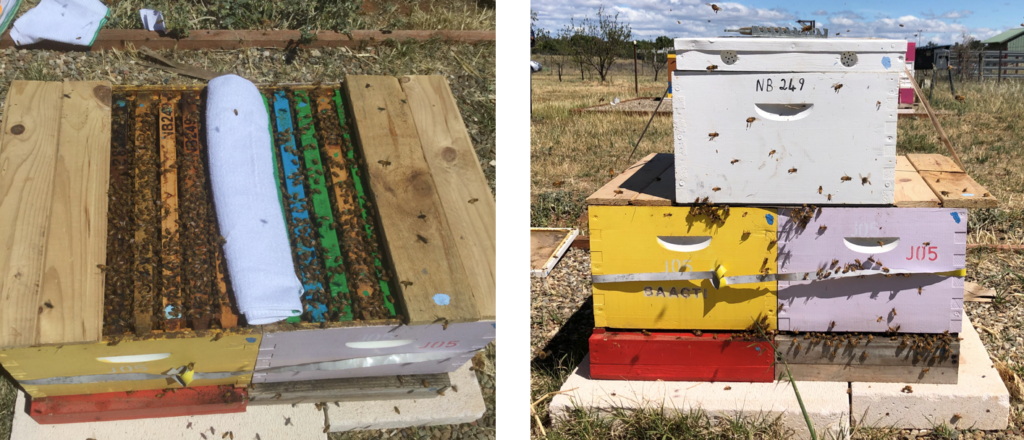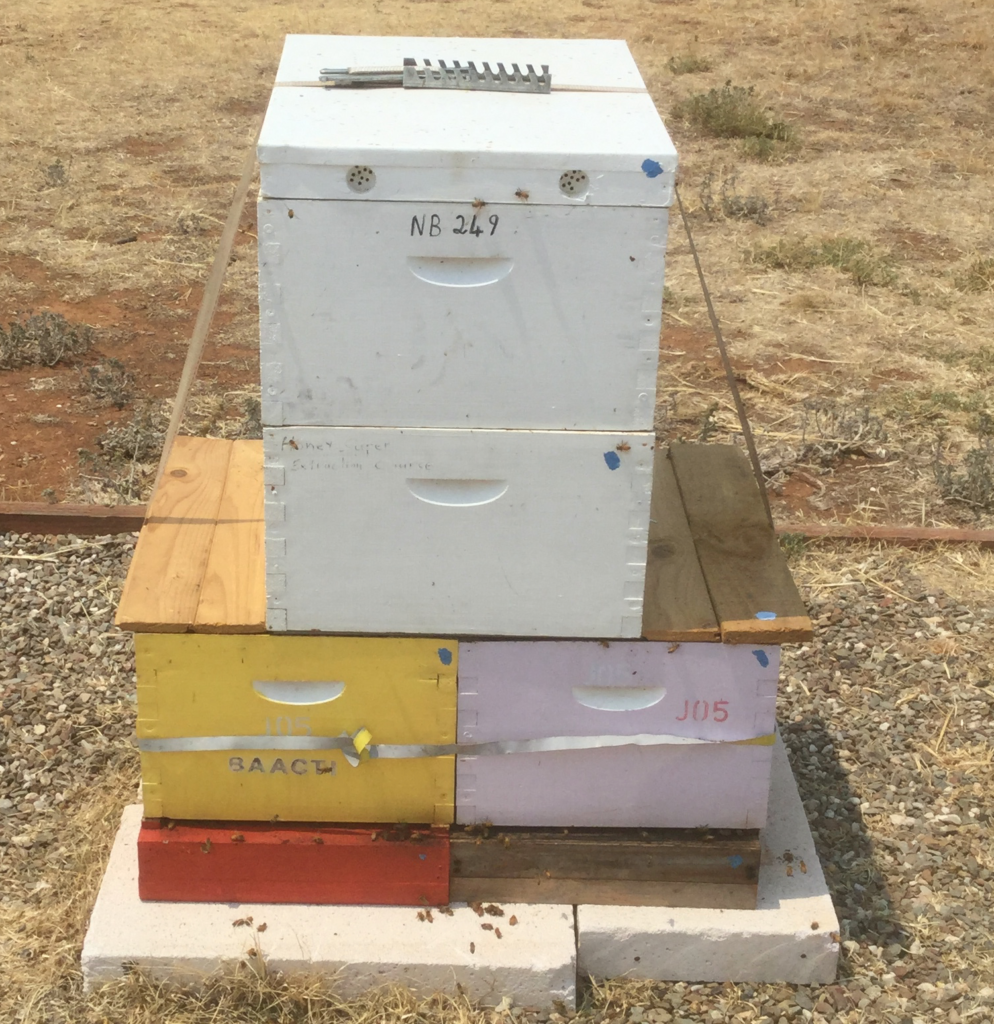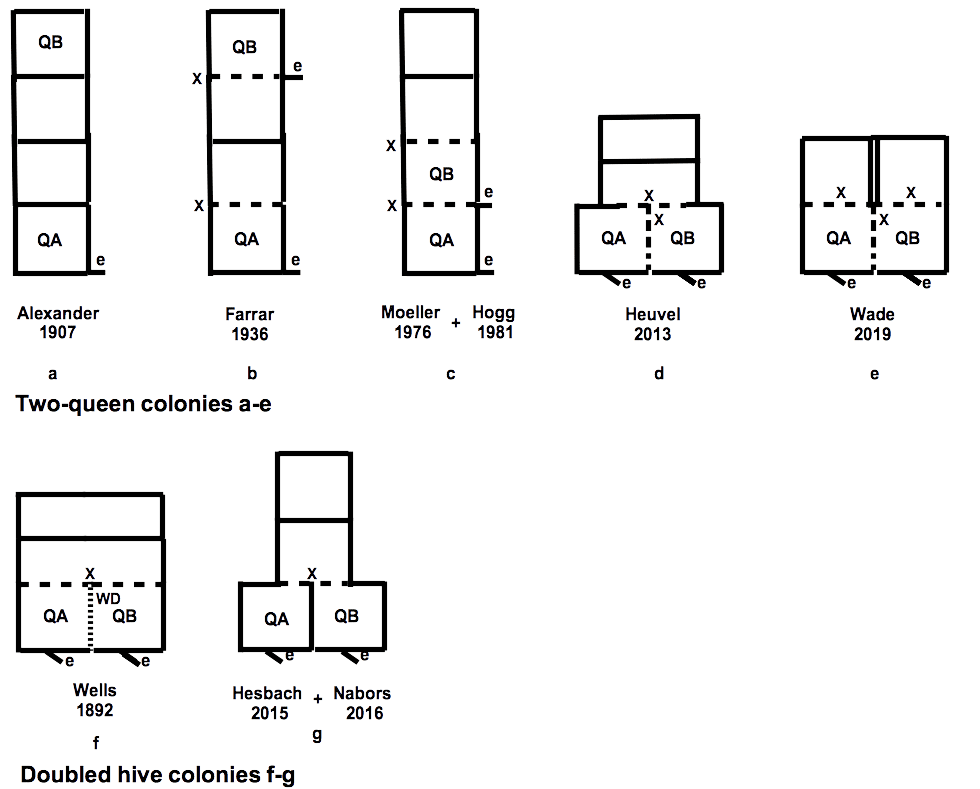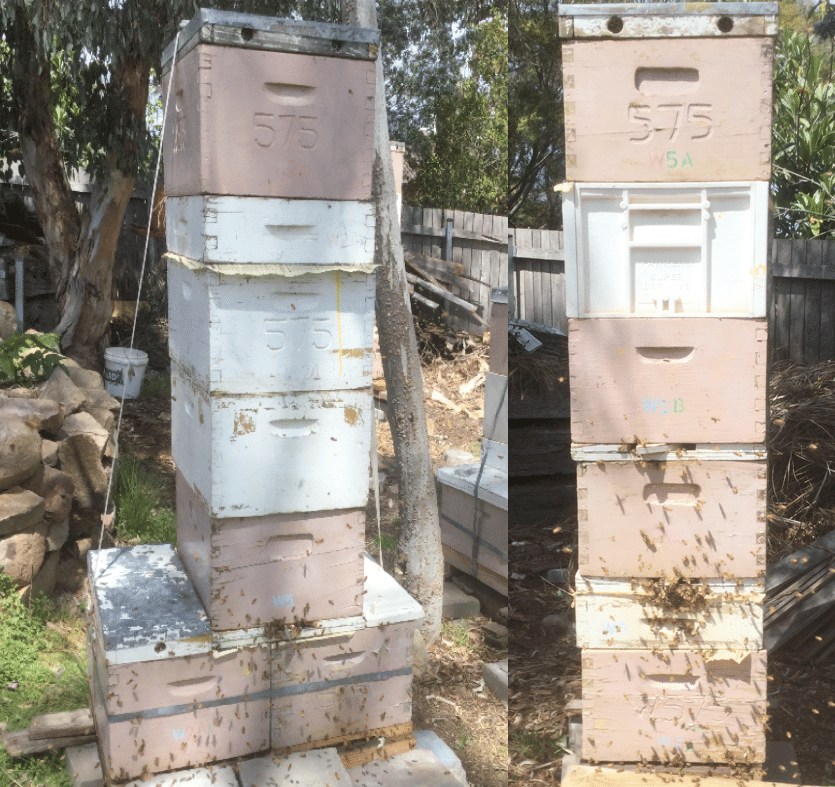
Alan Wade
Doubling hives is a remarkably old-fashioned way of keeping bees. I should know as I am of that ilk. But what is doubling and how does it differ from running common-or-garden single-queen hives or the more challenging two-queen colony?
Perhaps the most distinctive feature of hive doubling – yes there are two queens – is that of achieving and maintaining bee populations far exceeding those normally achieved in a single-queen colony across the whole beekeeping season. Put simply that amounts to having really strong bees from the earliest fruit blossom through to the last trickle of nectar in autumn. Doubled hives can be almost as readily set up as single-queen hives and they suffer few of technical hurdles that beset establishment and operation of two-queen hives.
Gaming the honey gathering business
This year the Two Queen Special Interest Group has been attempting to emulate the hive doubling scheme to see for ourselves how the original Wells doubled hive works. But the real and ulterior motive has been to try to cash in on an early and likely only honey flow for the forecast coming exceptionally dry season.
The honey crops obtained by doubling hives, that is using separate hives each containing their own queen, but using their combined workforce to store honey, are rarely achieved with equivalent pairs of single-queen hives. In the strictest sense doubled hives are not two-queen hives, well certainly not in the sense that two queens can be worked together in a single broodnest. Nevertheless doubled hives were the first ever colonies to be managed containing two queens.

Canberra Region Beekeepers doubled hive November 2019
Double 8F brood box setup (L) with 10F super over 10F excluder (R)
Below:
Under-supering mid season under severe drought conditions December 2019

It has taken our coterie of two-queen beekeepers some years to fully distill the essential differences between a multitude of systems of operation of honey bee colonies containing more than the one regular queen. Semantics aside, the diagram depicts the essential features of all the two-queen and doubled hive systems that we’ve come across. There are some subtleties in their set up and operation that are described elsewhere (see Readings). These will be the topics for 2020 editions of Bee Buzz Box.

Historical colony setups with two queens: QA and QB queens, X=excluder, WD=Wells Dummy, e=entrance:
(a) E.W. Alexander’s finessed multiple-queen hive
(b) Clayton Farrar’s classic commercial two-queen hive
(c) Floyd Moeller’s – John Hogg’s CBN two-queen hive facilitating standard honey flow super management
(d) Bernard Heuvel’s horizontal CBN two-queen hive
(e) Alan Wade’s (2018) and Frank Derwent’s (2019) horizontal CBN two-queen hives
(f) George Well’s System doubled hive
(g) William Hesbach’s and Ray Nabors’ tower doubled hive.
However the devil of their operation is in the detail. There are many traps for the unwary, most relating to the seasonability of operation of colonies with more than one queen and more especially strictures for the successful establishment of two-queen hives. Amongst the many maladies of running two-queen hives, as opposed to doubled hives, is that they are notorious for reverting to single-queen hives unless conditions are ‘just right’. However they are reputed to be much less swarm prone and are potentially even more productive than doubled hives.
Doubled hive origins
The art of doubling hives was largely lost in the early 20th Century: its success was faithfully recorded for posterity and will be the topic of the next Bee Buzz Box. The doubled hive system has regained support very recently, though under a different guise, employing standard equipment. While the use of standardised gear is sensible, many of the finer points of the operation of the original doubled hive operation (Wells System) have been all but forgotten. So it would appear that a timely reflection of the invention of the doubled hive system, one that might be readily adopted by a dedicated back-yarder, might be warranted.
I first came across doubled hives while idly perusing my copy of the Tuesday 17 May 1904 edition of the West Gippsland Gazettei. George Wells, a retired brick-maker foreman became quickly famous harvesting astounding amounts of honey from his Aylesford, Kent back garden. In the spring of 1892, this very erudite gentleman presented his findings to the British Bee-Keepers Association Quarterly Converzationeii. Wells System hives dominated the pages of the prestigious British Bee Journal, Bee-Keepers’ Record and Adviser – now The British Bee Journal (BBJ) – throughout the 1890s and into the early nineteen naughties.
That many were able to emulate his success drew wide scale accolades for Wells and support for him from the wily and astute editors of the BBJ. Despite his many detractors, and the carping of many ignorant and incompetent operators, Wells fame grew and he became a favourite speaker at beekeeper association meetings. On one occasion he receiving ninety letters of enquiry of his system in just a single dayiii. Not a bad score given that social media was only to come to the fore almost a century and a quarter later. Then, almost inexplicably, the Wells System vanished from the annals of beekeeping.
Like the radio serial on your crystal set – sorry most of you are too young to have even heard of either – you will have to tune into more episodes to discover how the principle innovators George Wells and, in later editions, E.W. Alexanderiv, Clayton Leon Farrarv, and Floyd Moellervi and John Hoggvii made operating hives with two or more queens successful. Here we discuss how a contrived version of the Wells system has gained some resurgence in the past few years.
A backyarder’s tale
This year early doubled and two-queen hives have already jollied on a light Red Box (Eucalyptus polyanthemos) flow. The picture shows two of nine hives on trial in member and club hives, now seemingly reliant on suburban Iron Bark (Eucalyptus sideroxylon/tricarpa) and Callistemon spp benefitting from garden watering. Multiple entrances make the field-force bees task of delivering their harvest so much easier.

Doubled and two-queen hives set up at the commencement of Red Box flow in mid October 2019. Note multiple entrances and strapping of the doubled hive brood boxes to align brood chambers for honey supering.
Doubled Hives: Thanks to global warming, it’s actually been cookie enough over the last three years for sustained October Red Box flows. Common remnant woodland Red Box trees flower in southern Australian box woodland almost every year. But an actual Red Box flow – it’s nearly always too dry and too cold – has been a rare event over the last thirty years. However, with a hot and dry summer forecast, the early flow – if soil dryness does not entirely beat us – may be an ominous portent of an exceptionally poor season ahead.
The original 1890’s Wells System of hive doubling relied on a range of subtle measures including use of productive young queens, dividing really strong hives (ideally doubled over the past season) in autumn and closely abutting these single-queen units using a thin-walled partition to enable each colony to share its neighbours warmth to overwinter. To quote Wells:
I am very pleased to find so many bee-keepers giving the double-queen system a trial, and also glad to note that some are comparing results, viz., one hive with two queens against two hives with but one queen in each; but I hope that all who are testing the double queen system on these lines will bear in mind that they do not really prove its merits or demerits unless they began their operations when packing up their bees for winter. – George Wells 1893
Then, in early spring, the giant twenty frame Wells hive with perforated partition (The Wells Dummy) – a double ten-frame brood chamber – is supered above over a large queen excluder [referred quaintly to as ‘excluder zinc’] with full-width (twenty frame) shallow supers without any central division board. The resulting powerful colonies made very early increase on spring blossom and – for that era – produced annual crops that were nothing short of astounding.
The carpentry skills required to build a Wells Hive, then popular, now seems rather too daunting a task. However one does not need to exactly replicate the original scheme of operation, instead employing the William Hesbach and Ray Nabors Systemviii. As we have seen – see photo above – this comprises two separate single queen hives, in separate standard brood boxes, sharing – over a central excluder – common nectar ripening and honey storage space all using standard full depth Langstroth gear. In adopting this system we miss out on the ‘shared warmth’ of the original Wells hives and the common pheromone signalling, so the colonies need uniting using newspaper when first supering in spring. With the advent of highly insulated polystyrene gear and autumn requeening this overwintering problem is overcome and colonies emerge as strong hives in late winter. Pairs of these single eight or nine frame hives, lined up side-by-side can be united on the very first warm late winter or early spring day.
Two-queen hives: In the modern Moeller-Hogg form, a vertical two-queen setup comprises a shared consolidated brood nest, that is a single large nest, the two queens only kept apart by an excluder. Honey supers are managed in exactly the same way as they are in any single queen system operation. However they are so productive that their benefit is sacrificed if honey is not promptly removed. The alternative Bernard Heuvelix horizontal two-queen system has received scant attention though a similar hive was run very successfully at the club apiaryx during the bumper season of 2018-2019.
Traditionally two-queen hives are started much later in the season than are doubled hives. Like doubled queen hives the timing of their operation is critical to their success. In most published records, two-queen hive establishment is contingent upon building and splitting a single queen hive in mid spring then rebuilding the splits so they can be reunited and run as two-queen colonies at the beginning of the main flows from late spring to early summer.
In future instalments we will examine the evolving history of two-queen hives, that is after we have more closely reviewed the ground-breaking efforts of George Wells to establish doubled hives dating from the early 1890s.
For the regular bee owners with an interest in having buzzers for keeps’ sake, one might be more content with perfecting single-queen hive operation, namely keeping healthy gentle bees, maintaining good hive nutrition and providing adequate brood and honey storage space. By managing your bees well you will nearly entirely avoid swarming and you will get a whole lot more honey than the owner of bees down the street who, like you, has one or two hives . That way, and in a good year, you will always have enough honey for the table and that honey stall.
Readings
iBee (1904). Wells hive and system. West Gippsland Gazette, 17 May 1904, p.4. https://trove.nla.gov.au/newspaper/article/68708484?searchTerm=wells%20system&searchLimits=#
iiBritish Bee-Keepers’ Association Quarterly Converzatione (Thursday March 31, 1892). Mr Wells new method of working bees. The British Bee Journal and Beekeepers’ Record and Adviser 20(510):126, 132-133. https://ia802508.us.archive.org/29/items/britishbeejourna1892lond/britishbeejourna1892lond.pdf
Wells, G. (May 10, 1894). British Bee Journal, Bee-Keepers’ Record and Adviser 22:183-184. The Wells System. Reply to Mr Walton’s open letter. https://ia600200.us.archive.org/3/items/britishbeejourna1884lond/britishbeejourna1884lond.pdf
iiiWells, G. (18 May 1893). Comparing the double and single-queen systems. The British Bee Journal and Beekeepers Record and Adviser 21(569):195-196.
ivAlexander,
E.W. (1907a). A plurality of queens without perforated zinc.
Gleanings in Bee
Culture
35(23):1136-1138.
https://babel.hathitrust.org/cgi/pt?id=umn.31951d00953180r;view=1up;seq=660
Alexander,
E.W. (1907b). The plural queen system: all queens but one disappear
at the end of the season. Gleanings
in Bee Culture 35(17):1496.
https://babel.hathitrust.org/cgi/pt?id=hvd.32044106180268;view=1up;seq=562
vFarrar, C.L. (1936). Two-queen vs. single-queen colony management. Gleanings in Bee Culture 64(10):593-596.
Farrar, C.L. (May 1946). Two-queen colony management. United States Department of Agriculture. Agricultural Research Administration. Bureau of Entomology and Plant Quarantine, 14pp. http://ufdc.ufl.edu/AA00026061/00001/14j
viMoeller, F.E. (April 1976). Two queen system of honeybee colony management. Production Research Report 161, Agricultural Research Service, United States Department of Agriculture, 15pp., Washington DC 20402. http://naldc.nal.usda.gov/download/CAT87210713/PDF and http://mesindus.ee/files/52221134-2-queen-management.pdf
viiHogg, J.A. (1981). The consolidated two-queen brood nest and queen behavior. American Bee Journal 121(1):36-42. http://www.twilightmd.com/Samples/Hogg/Hogg_Halfcomb___Publications/ABJ_1981_January.pdf
Hogg, J.A. (1983). Methods for double queening the consolidated broodnest hive: the fundamentals of queen introduction, 1. American Bee Journal 123(5):383-388. http://www.twilightmd.com/Samples/Hogg/Hogg_Halfcomb___Publications/ABJ_1983_1May.pdf
Hogg, J.A. (1983). Methods for double queening the consolidated broodnest hive: the fundamentals of queen introduction. The fundamentals of queen introduction, 2. Conclusion. American Bee Journal 123(6):450-454. http://www.twilightmd.com/Samples/Hogg/Hogg_Halfcomb___Publications/ABJ_1983_2June.pdf
viiiHesbach, W. (2015). Two queens, one hive=lots of honey. Honey Bee Suite https://honeybeesuite.com/two-queens-one-hivelots-of-honey/
Hesbach, W. (22 February 2016). The horizontal two-queen system. Bee Culture http://www.beeculture.com/the-horizontal-two-queen-system/ Nabors, R. (1 August 2016). Comparing two-queen colony management methods. American Bee Journal 156(8). Beekeeping topics http://americanbeejournal.com/comparing-two-queen- colony-management-methods/
ixHeuvel, B. (March 2013). Running two-queen colonies. Beesource http://www.beesource.com/forums/showthread.php?306234-Running-two-queencolonies&p=1202508#post1202508
xWade, A. (2019). Establishing two queens instead of one queen in a honey bee colony Part III. Operating two-queen colonies. The Australasian Beekeeper 120(10):22-25.

Be the first to comment